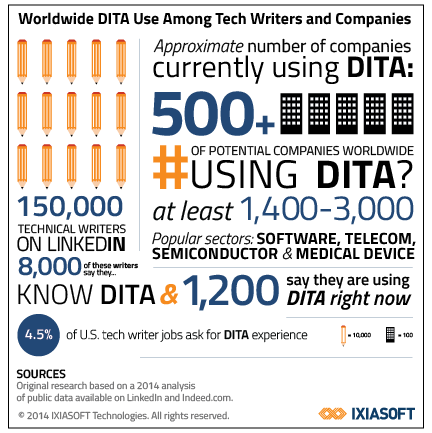
A longer version of this piece originally appeared in the December 2014 issue of CIDM’s Best Practices Newsletter as “DITA Diversity in Technical Documentation”. The full version (PDF format) is available courtesy of IXIASOFT.
While we are still far from seeing DITA as the default choice for technical documentation around the world, what is apparent is the increased adoption rate of DITA outside of the core software and information technology sectors where it first took root. In fact, these days there seems to be no industry sector that DITA has not been adapted to, and there is evidence of companies operating in almost 60 types of businesses. DITA may not be ubiquitous yet, but its spread among such a broad number of firms suggests a broad appeal.
Given mature processes, toolsets and an all-too-common need to make documentation processes as efficient as possible, it was really only a matter of time before DITA usage started to pick up steam outside of its core base. So how widespread is DITA usage? My estimates are rough, but based on data derived from LinkedIn references correlated to American job listings on Indeed.com it appears that about 5% of all technical writers are using DITA. There are approximately 150,000 technical writers listed on LinkedIn with 8,000 claiming DITA knowledge, which comprises 5% of the whole. On the Companies Using DITA listing elsewhere on this website, there are now over 500 companies using DITA, a figure derived primarily from over 1,400 individual technical writers claiming current DITA experience on LinkedIn. Going by the ratio of technical writers to companies and the rates of DITA adoption, this information implies that potentially there are 1,400 – 3,000 firms worldwide currently using DITA.

These numbers may seem small when compared to the whole technical communications industry, but consider that only about 15% of all technical writers on LinkedIn claim FrameMaker experience, which has been a cornerstone of professional documentation software for almost a quarter of a century. And then consider the fact that DITA has existed for less than half of that time.
The pace at which DITA is spreading outside of its core software/high-tech sectors also appears to be picking up. It has already made significant inroads into the Telecommunications sector (including Sandvine, Nokia, Huawei and Ericsson to name a few), Semiconductors (ARM, Infineon, Altera and many more), and the Medical Device sector (Varian, Boston Scientific, Bayer and CareFusion among others), together comprising 18% of known companies using DITA.
There are over 20 sectors represented among DITA using firms, each comprising 1% – 3% of the overall total. The following list contains these sectors along with a couple of representative companies whose technical writing departments are known to be using DITA:
- Electrical/Electronic Engineering (Schneider Electric, Raymarine)
- Financial Services (MasterCard, VISA)
- Machinery (Caterpillar, Komatsu)
- Mechanical or Industrial Engineering (Danfoss, HIAB)
- Automotive (Renault Trucks, Tata Motors)
- Oil and Energy (Schlumberger, Chevron, Siemens Wind Power)
- Internet (eBay, PayPal)
- Education Management (Blackboard, Kaplan)
- Publishing (Oxford University Press, Triumph Learning)
- Computer and Network Security (McAfee, CyberSafe)
- Higher Education (Indiana University, Thompson River University)
- Printing (Yamagata, Jyocera)
- Computer Hardware (Cray, Epson)
- Computer Networking (Cisco, Brocade)
- Nonprofit Organizations (UNICEF, World Agroforestry Centre)
- Pharmaceuticals (Elekta, Abbott)
- Consumer Electronics (Dolby, Brother)
- Consumer Goods (Electrolux, BRP)
- Defense and Space (L3 Wescam, SDI)
- E-Learning (Complete Curriculum, WebAssign)
- Insurance (California Casualty, ICBC)
After this comes the “Other” category, comprising 11% of all firms using DITA. While the numbers are small—over 20 industry sectors, sometimes with only a single firm representing an industry sector—the diversity represented strongly suggests that DITA is moving into a new phase of wider adoption. These additional sectors include:
- Aviation & Aerospace (Delta Airlines, Insitu)
- Research (National Cancer Institute, U.S. National Library of Medicine)
- Broadcast Media (Grass Valley)
- Entertainment (DeNA)
- Government Administration (U.S. Veterans Health Administration)
- Human Resources (ADP)
- Maritime (Kongsberg Maritime)
- Package/Freight Delivery (Fedex)
- Renewables and Environment (Vestas)
- Staffing and Recruiting (Adecco Group)
- Utilities (Dominion)
- Wireless (HTC)
“Success is the Sum of Small Efforts, Repeated”
This quotation from Robert Collier sums up why DITA—or DITA ways of thinking—is becoming pervasive in the technical documentation world. Certain needs will always be a driving factor in pushing companies to consider adopting standards like DITA, especially the need for efficient content reuse and consistency. Its built-in adaptability through specialization has also helped people extend the functionality of DITA into niche areas. I also believe that the simplicity of topic types in DITA made it a relatively easy way to enter structured authoring, and that the minimalist writing principles it advocates “clicked” with a lot of technical writers. This is why DITA has taken off in the way that it has: writers from an initial DITA implementation at one firm eventually move on to other companies and bring the idea of using DITA with them. In this way, there has been a “cross pollination” of DITA usage outside of the original software sector to every other sector it has touched. Tools supporting DITA have matured, allowing more and more companies outside of the software/high-tech sectors to take full advantage of the standard.
In terms of its technological adoption lifecycle we are witnessing the definite end of the early adopter stage of DITA usage and have moved into the “early majority” phase—meaning that we are entering a period of maturation in the marketplace as technical writers with DITA knowledge and skills increase in number. Don’t take “majority” in the sense that all technical writers are using DITA—MS Word is still by far the most popular technical writer “tool” out there—but instead as a long-term period of continued growth, where DITA’s influence increases and more firms that are more conservative in their nature than the “early adopter” companies pick it up as a business practice. There is clear evidence of increasing diversity in firms using DITA and their use of mature tools and best practices bequeathed to them by these early adopters. It is safe to say that we will see continued growth in the use of DITA worldwide over the next few years.
(This blog post originally appeared on the IXIASOFT website on February 3, 2015).

Great info. Lucky me I recently found your blog by chance (stumbleupon).
I have bookmarked it for later!